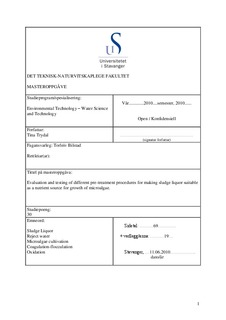Evaluation and testing of different pre-treatment procedures for making sludge liquor suitable as a nutrient source for growth of microalgae
Master thesis
Permanent lenke
http://hdl.handle.net/11250/182438Utgivelsesdato
2010Metadata
Vis full innførselSamlinger
Sammendrag
The objective for this thesis is to find a proper pre-treatment for sludge liquor for the purpose of growing microalgae in the treated solution. Sludge liquor (also called reject water) is the reject/centrate after the dewatering of the sludge after it has undergone anaerobic digestion, and is normally recycled to the inlet. It is characterized as a high turbid and high content of solids I addition to a high nitrogen load (especially ammonium) and phosphorous.
Sludge liquor from four different wastewater treatment plants was characterized and different pre treatment methods were conducted. The different pre-treatment methods tested was aeration, oxidation, coagulation and flocculation (by testing different polymers), mediafiltration and centrifugation. Combinations of these were also tested. The efficiency of treatment was measured in % transmittance, which gives an indication of the light penetration properties of the solution which is crucial for microalgae growth, and also turbidity and solids removal.
Oxidation and aeration did not improve the transmitting properties of the sludge liquor samples. The best treatment method was coagulation and flocculation by polymers, combined with centrifugation.
Microalgae did grow in pretreated sludge liquor (diluted 1:5.5) added phosphate, so with optimization of pre-treatment and finding a optimal growth media, growth of microalgae in sludge liquor can be enhanced.
Beskrivelse
Master's thesis in Environmental technology: water science
